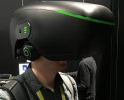cheapchips
Veteran
Sony: Mobile PS5/PS5 Pro Switch, essentially. Keep backwards compatibility for both implicit for a long while, PS5 base BC in handheld and PS5 Pro BC in docked. People want handheld devices, and care less and less about each console generations "upgrades". Sure you can have upgrades for the future, 18-24gb of ram, a GPU with high end matrix multiplication and formats, maybe even a dedicated high end NPU. Note: on current devices these are for constant low end AI calculations while GPU is for intensive workloads. However NPUs are more power efficient here, and for a mobile console a large one that can do constant intensive work might make sense power wise.
Plus you get to take the controllers off the side and turn the screen/processing into a VR headset for cheap. Maybe Apple Vision comes along and makes AR/VR super popular in a year or two (2025, 26?). Sure this makes the base unit more expensive, you need a 4-5k screen and extra cameras and watnot. But this way you can sell a VR kit not for $549 but $199, way cheaper. And at $699 total you're probably selling a high end AR/VR headset as cheap or cheaper than anyone else is.
Portable PS5 seems like a topic of it's own really. A shrunk PS5 SoC is a bad chip for such a device. They need to up their BC game!
Portable devices slotting into a headstrap is a terrible VR experience. The weight distribution is all wrong. It's a step backwards even against the bargain basement efforts they've offered so far. By the time we get to 2028+, thin lenses and micro oled should be cheap enough that everyone else is offering thin and light devices. Sony can't come along with some that looks like this:

They'd be better off their portable PS5 being a stand alone HMD, with it operating as a wireless HMD for PS6.
